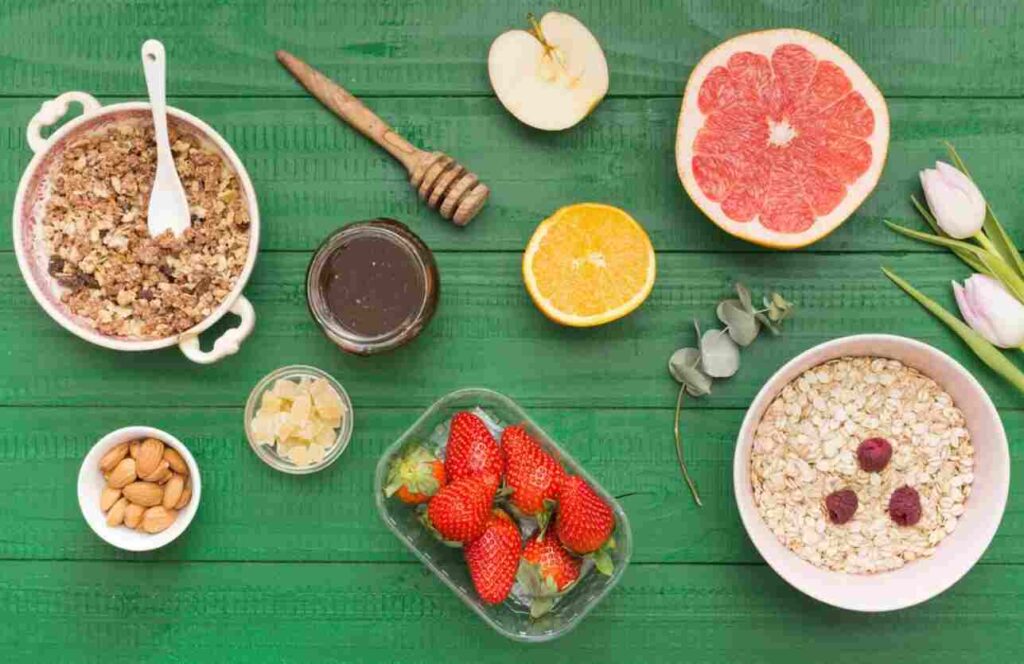Life Cereal, a popular breakfast option from Quaker Oats, has been a household favorite for decades. Known for its whole-grain oats, it markets itself as a heart-healthy choice that’s quick, easy, and versatile.
But the question many health-conscious individuals ask is: Is Life Cereal actually healthy? While it offers some nutritional benefits, such as being high in fiber and fortified with vitamins, it also contains added sugars and processed ingredients that may raise concerns for certain diets.
We’ll dive into the ingredients and nutrition facts, explore the health benefits, and address potential drawbacks.
Whether you’re looking to manage your weight, control blood sugar levels, or simply make a smarter breakfast choice, this guide will help you decide if Life Cereal fits into your healthy lifestyle.
Ingredients in Life Cereal

Life Cereal contains a mix of simple ingredients that contribute to its taste and nutritional profile. Here’s a breakdown of the main components
Whole Grain Oat Flour
This is the primary ingredient in Life Cereal and a great source of fiber and essential nutrients like iron. Whole grains, particularly oats, are known for promoting heart health and aiding digestion due to their high fiber content.
The use of whole grain oat flour is a key selling point for the cereal, positioning it as a healthier breakfast option.
Sugar
Sugar appears early on the ingredient list, making it a significant component of Life Cereal. While it contributes to the cereal’s slightly sweet flavor, it also raises concerns about the overall sugar content.
One serving contains around 8 grams of sugar, which is relatively high compared to other cereals marketed as healthy.
Excessive sugar consumption can lead to blood sugar spikes and weight gain, making it a less ideal option for those seeking low-sugar foods.
Canola Oil & Other Oils
These oils are included in the cereal for texture and flavor. While they provide healthy fats, such as omega-3 fatty acids from canola oil, they can also add unwanted calories and fats to your diet. These oils are common in many processed foods, but they are still a step away from more natural options like nuts or seeds.
Artificial Flavors & Preservatives
Some varieties of Life Cereal contain artificial flavors and preservatives to maintain freshness and enhance taste. While these additives help prolong shelf life, they are considered less desirable in a healthy diet compared to natural ingredients.
Comparison to Other Breakfast Cereals
When compared to other common cereals, Life Cereal falls somewhere in the middle in terms of nutrition:
Healthier than sugary cereals like Froot Loops or Frosted Flakes, which can contain 12g+ of sugar per serving.
Comparable to Cheerios, but slightly higher in sugar and processed oils.
Less processed than some heavily refined cereals but contains more additives than truly whole-food options like oatmeal or homemade granola.
When compared to other breakfast cereals, Life Cereal’s ingredients are relatively standard but not without concerns. Many cereals—especially those targeting health-conscious consumers—contain similar processed ingredients.
However, cereals like Cheerios or Kashi GoLean use fewer added sugars and preservatives, offering more fiber and fewer artificial additives.
In contrast, sugary cereals like Frosted Flakes or Lucky Charms contain significantly more added sugars and artificial flavoring, making Life Cereal a better choice for those seeking a balance of nutrition and taste.
Life Cereal Nutrition Facts
Life Cereal provides a mix of whole grains, fiber, and added vitamins, but it also contains added sugars and processed ingredients. Here’s a breakdown of its nutritional profile per 1-cup (42g) serving:
| Nutrient | Per 1 Cup (42g) Serving |
|---|---|
| Calories | ~160 kcal |
| Carbohydrates | ~33g |
| Sugars | ~8g |
| Fiber | ~3g |
| Protein | ~4g |
| Fats | ~2.5g |
| Iron | ~60% DV |
High in Carbohydrates & Sugar
⚠️ Concerns About Sugar Content
With 8g of sugar per cup, Life Cereal is higher in sugar than some whole-grain cereals like plain Cheerios (~1g sugar per serving).
While it’s lower in sugar than highly processed sugary cereals like Frosted Flakes (~12g sugar per cup), it still contributes to added sugar intake, which can impact blood sugar levels and weight management.
The American Heart Association (AHA) recommends no more than 25g of added sugar per day for women and 36g for men, meaning Life Cereal provides a significant portion of that limit.
Decent Fiber Content
✅ Moderate Fiber Compared to Other Cereals
Life Cereal contains 3g of fiber per serving, which supports digestion and helps maintain fullness.
However, it falls short of high-fiber cereals like Kashi GoLean (10g fiber per serving) or bran-based cereals (8g+ fiber per serving).
Fortified with Vitamins & Minerals
✅ Good Source of Iron & B Vitamins
Iron: With 60% of the daily value (DV) per serving, Life Cereal helps prevent iron deficiency anemia, making it beneficial for children, women, and those with iron needs.
Folic Acid & B Vitamins: These support energy metabolism, brain health, and red blood cell production.
Calcium & Vitamin D: Some varieties may also be fortified with bone-supporting nutrients.
Life Cereal offers some nutritional benefits, such as whole grains, fiber, and added vitamins, but its high sugar content and processed ingredients may be concerning for those looking for a healthier breakfast option. If you enjoy Life Cereal, consider
✔ Pairing it with a protein source (e.g., Greek yogurt or eggs) to balance blood sugar.
✔ Choosing lower-sugar alternatives like plain oats, unsweetened cereals, or homemade granola.
✔ Watching portion sizes to minimize excessive sugar intake.
Health Benefits of Life Cereal

Life Cereal is often marketed as a nutritious breakfast option, thanks to its whole grains, fiber, and fortified vitamins.
While it does contain some processed ingredients and added sugars, it also provides certain health benefits that make it a better choice than many overly processed, sugary cereals.
✅ Contains Whole Grains
Life Cereal’s primary ingredient is whole grain oat flour, which is known for its potential heart health benefits.
Oats contain beta-glucan, a type of fiber that may help lower cholesterol levels, reducing the risk of heart disease.
Whole grains are also linked to better digestion and stable blood sugar levels compared to refined grains.
✅ Source of Fiber
With 3g of fiber per serving, Life Cereal provides a moderate fiber boost, which supports digestion and helps regulate bowel movements.
Fiber also plays a role in keeping you full for longer, which may prevent overeating or mid-morning energy crashes.
However, some other cereals—like bran-based or high-fiber options—offer significantly more fiber.
✅ Fortified with Essential Nutrients
Life Cereal is enriched with vitamins and minerals, making it a good source of
Iron (60% DV per serving): Helps prevent iron deficiency anemia, particularly important for women and children.
Folic Acid & B Vitamins: Support energy production, brain health, and red blood cell formation.
Some varieties may also contain calcium and vitamin D, which are essential for bone health.
✅ Lower in Fat
Life Cereal has only ~2.5g of fat per serving, making it a lower-fat choice compared to cereals that contain nuts, seeds, or coconut.
However, its fat content comes from vegetable oils, which may not be the healthiest source.
Life Cereal provides some key health benefits, including whole grains, fiber, and essential nutrients.
However, its added sugar content and processed ingredients make it less ideal than minimally processed alternatives like plain oatmeal or homemade granola.
If you enjoy Life Cereal, consider pairing it with protein-rich foods (e.g., Greek yogurt, eggs, or nuts) to create a more balanced meal.
Is Life Cereal Good for Weight Loss?

Life Cereal is often considered a convenient and somewhat nutritious breakfast option, but whether it’s suitable for a weight-loss diet depends on several factors. Let’s break down the pros and cons to determine if it can fit into your weight loss plan.
Pros of Life Cereal for Weight Loss
✅ Lower in Fat
Life Cereal has only 2.5g of fat per serving, making it a low-fat breakfast option compared to many other cereals, which may contain added oils, nuts, or seeds that increase fat content.
For individuals looking to reduce fat intake, this makes Life Cereal a relatively good choice.
✅ Contains Fiber
With 3g of fiber per serving, Life Cereal can contribute to satiety (feeling full for longer), which may help reduce overall calorie intake throughout the day.
Fiber also plays a role in regulating digestion and blood sugar levels, which are important when managing weight.
✅ Fortified with Nutrients
Life Cereal is fortified with iron, folic acid, and B vitamins, providing essential nutrients that support energy metabolism and overall health, which can be beneficial when reducing calorie intake.
Cons of Life Cereal for Weight Loss
⚠️ High in Carbs & Added Sugars
One of the biggest concerns for weight loss is that Life Cereal contains 33g of carbohydrates and 8g of sugar per serving.
Carbs, especially refined ones, can contribute to blood sugar spikes followed by energy crashes, which may increase hunger and cravings. Excessive sugar intake has also been linked to weight gain and other metabolic issues.
For individuals on low-carb or ketogenic diets, Life Cereal may not be the best choice due to its high carbohydrate content.
Comparison to Higher Protein or Lower-Sugar Breakfast Options
When compared to higher protein or lower-sugar breakfast options, Life Cereal might not be the most weight-loss-friendly choice:
Oatmeal – A better option for weight loss. Oats are lower in sugar, high in soluble fiber (beta-glucan), and may keep you fuller for longer without causing the same blood sugar spikes as sugary cereals.
Greek Yogurt with Berries – A higher-protein, lower-sugar option that can help with muscle maintenance and fat loss. Greek yogurt provides more protein than Life Cereal, helping with satiety and supporting lean muscle while managing calories.
While Life Cereal has some benefits like low fat, fiber, and essential nutrients, its high carb and sugar content make it a less-than-ideal choice for weight loss.
If you’re aiming to lose weight, it’s best to opt for lower-sugar, higher-protein options, such as oatmeal, Greek yogurt, or eggs.
You can still enjoy Life Cereal occasionally, but be mindful of portion sizes and pair it with protein or healthy fats to help balance your blood sugar levels and stay full longer.
Is Life Cereal Healthy for Diabetics?
For individuals with diabetes, managing blood sugar levels is crucial, and the foods we consume can significantly impact these levels. Life Cereal, with its high carbohydrate and sugar content, may not be the best choice for those trying to control their blood glucose.
Glycemic Impact of Life Cereal
Life Cereal contains 33g of carbohydrates and 8g of added sugar per 1-cup serving. The high sugar content can cause a rapid increase in blood glucose levels, which may be challenging for diabetics to manage.
Additionally, Life Cereal’s glycemic index (GI) may be relatively high, meaning it can lead to quick spikes in blood sugar, followed by crashes. This is especially concerning for diabetics, who need to be mindful of foods that cause these blood sugar fluctuations.
Better Breakfast Options for Diabetics
✅ Oatmeal (without added sugar)
Oats are a great choice for diabetics. They have a lower glycemic index compared to sugary cereals and provide fiber to help stabilize blood sugar levels.
Choose unsweetened oatmeal, and add nuts or berries for healthy fats and a natural sweetness without sugar.
✅ Egg-based Breakfasts
Eggs are an excellent source of protein and healthy fats, which have minimal impact on blood sugar levels.
They provide lasting satiety and help with blood sugar control. Pair them with vegetables or avocado for a more balanced meal.
✅ Low-carb, High-protein Cereals
Look for low-carb cereals that are rich in protein and fiber but low in sugar. These options are designed to help keep blood sugar levels stable without the spikes caused by sugary cereals.
For diabetics, Life Cereal may not be the healthiest breakfast option due to its high sugar and carb content. Oatmeal, eggs, or low-carb cereals are better alternatives for controlling blood sugar levels while providing essential nutrients. Always consult with a healthcare professional for personalized dietary advice.
Healthier Alternatives to Life Cereal
If you’re looking for a lower-sugar, high-fiber breakfast to start your day off right, there are several better alternatives to Life Cereal. These options provide more nutritional value, especially for those concerned about managing blood sugar and maintaining a healthy diet.
Healthier Cereal Options
✅ Cheerios (Plain, No Added Sugar)
Cheerios made with whole grains are a great alternative to sugary cereals. The plain version contains no added sugar and is low in calories, making it an ideal choice for those seeking a balanced, heart-healthy breakfast.
With 3g of fiber per serving, Cheerios can help with digestion and satiety without causing blood sugar spikes.
✅ Kashi GoLean
Kashi GoLean is a high-protein, high-fiber cereal that provides 11g of protein and 9g of fiber per serving.
This makes it an excellent choice for those looking for a more filling breakfast while keeping added sugars low. It also contains plant-based ingredients, such as soy and flax, providing healthy fats.
✅ Ezekiel 4:9 Sprouted Grain Cereal
Made from sprouted whole grains, Ezekiel 4:9 Cereal is a nutrient-dense, low-sugar option. Sprouted grains are easier to digest and may have a lower glycemic index than refined grains.
It’s rich in fiber and protein, which can help control blood sugar and provide long-lasting energy throughout the morning.
✅ Nature’s Path Organic Flax Plus
This cereal is packed with flaxseeds, which are high in omega-3 fatty acids, fiber, and antioxidants. With 6g of fiber per serving and no added sugars, it’s a great option for anyone looking to boost digestive health and heart health.
Homemade Breakfast Options
For those who prefer to avoid processed cereals altogether, here are some excellent homemade breakfast alternatives:
✅ Oatmeal with Nuts and Seeds
Oats are a whole grain that provides fiber and protein. Top your oatmeal with nuts (like almonds or walnuts) and seeds (like chia or flax) for extra healthy fats, protein, and fiber. This combination helps keep you full and stabilizes blood sugar.
✅ Greek Yogurt with Berries
Greek yogurt is an excellent source of protein, and pairing it with berries adds fiber and antioxidants without the added sugar of many cereals. This high-protein breakfast will help keep you satisfied longer.
✅ Smoothies with Protein and Fiber
Blend together leafy greens, berries, protein powder, and chia seeds for a nutrient-packed smoothie. This option is high in fiber and protein, making it an excellent choice for blood sugar regulation and weight management.
Opting for lower-sugar, high-fiber cereals like Cheerios, Kashi GoLean, or Ezekiel 4:9 can provide a more nutritious start to your day compared to Life Cereal.
Additionally, homemade options like oatmeal, Greek yogurt with berries, or protein-packed smoothies are fantastic alternatives for those seeking to reduce sugar intake and maintain long-lasting energy.
Frequently Asked Questions (FAQ)
Is Life Cereal good for heart health?
Life Cereal contains whole grain oat flour, which is beneficial for heart health due to its high fiber content. Fiber helps lower cholesterol levels and supports cardiovascular health.
However, the sugar content should be considered, as high sugar intake can negate some of its heart-healthy benefits.
Does Life Cereal have artificial ingredients?
Some varieties of Life Cereal contain artificial flavors and preservatives. However, the Original Life Cereal is relatively free of artificial ingredients, focusing on whole grains and natural flavors.
Always check the ingredient list to confirm, as flavors like Cinnamon may contain more additives.
Is Life Cereal high in protein?
Life Cereal provides 4g of protein per 1-cup serving, which is not considered high in protein compared to other breakfast options.
For a more protein-dense breakfast, consider alternatives like Greek yogurt, eggs, or high-protein cereals that provide a more substantial protein boost.
What are the healthiest cereals?
Some of the healthiest cereals include Cheerios (plain), Kashi GoLean, and Ezekiel 4:9 Sprouted Grain Cereal. These options are high in fiber, low in added sugars, and rich in essential nutrients. Always look for cereals made with whole grains and minimal added sugar for the best nutritional value.
Is Life Cereal gluten-free?
Life Cereal is not gluten-free. It contains whole grain oat flour, which does not meet the standards for gluten-free diets. Those with celiac disease or a gluten sensitivity should avoid Life Cereal and opt for certified gluten-free cereals made from rice, corn, or quinoa.
Conclusion
Life Cereal offers some benefits, including whole grains and fiber, which support heart health and digestion.
However, its added sugar content and high carbohydrate levels may make it less ideal for those focusing on weight loss or managing diabetes. While it can be part of a balanced diet, its glycemic impact may lead to blood sugar spikes.
For those seeking healthier breakfast options, consider low-sugar, high-fiber cereals like Cheerios, Kashi GoLean, or Ezekiel 4:9, or opt for homemade breakfasts such as oatmeal with nuts, Greek yogurt with berries, or protein-rich smoothies. These alternatives provide more stable energy and better blood sugar control.


